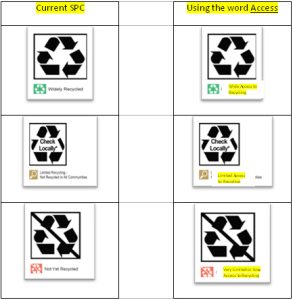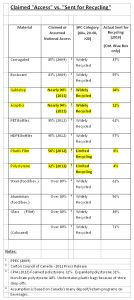Proposed environmental labeling system could lead to claims of industry greenwashing
The US-based Sustainable Packaging Coalition (SPC) has transplanted a UK environmental labelling idea to a North American context and is encouraging Canadian companies to pilot it. While we commend the initiative, in our opinion there is a serious danger that companies adopting it could leave themselves open to claims of greenwashing.
The problem lies in the current use of the word “Recycled” or “Recycling” in the SPC logos. In Canada, as in the US, claims about the recyclability of packaging hinge on the access question: on whether the consumer has access to recycling for that material through curbside, depot, deposit or whatever. Claims for recyclability in both countries have nothing to do with whether that material is actually sent for recycling.
So here’s the problem. The words on the three category boxes SPC has chosen (Widely Recycled, Limited Recycling, and Not Yet Recycled) do not mention access at all. But they imply that recycling has taken, or is taking place, at the levels cited (at least 60%, between 20% and 60%, and less than 20%).
Some examples of where the results of this approach can be very misleading:
Example 1: In Canada, the Carton Council (according to a 2011 press release) claims “nearly 94%” access to the recycling of gabletop and aseptics (and therefore under the SPC model would be able to claim “Widely Recycled”). But in fact, at least in Ontario’s residential Blue Box program, the actual sent for recycling rate for gabletops and aseptics in 2010 was only 34% and 12% respectively. That’s not exactly “Widely Recycled”, although we recognise that one province’s numbers, while admittedly a major one, don’t tell the whole story.
Example 2: While access to polystyrene recycling in Canada is increasing (placing it in SPC’s between 20% and 60% “Limited Recycling” category), its actual sent for recycling rate (again using Ontario residential numbers only) was only 4% in 2010 (the latest year for which data is currently available).
Under the SPC model, both examples cited above would appear to be over-claiming, and in effect, blurring the crucial distinction between access and actual recycling. Indeed the media (and presumably consumers), would be totally misled by the recent treatment in Canadian Packaging and Canadian Manufacturing magazines of a CPIA press release on access to plastics recycling. CPIA was meticulous in qualifying its statements with the “access” word. Canadian Packaging, however, completely missed the qualifiers and stated the access numbers as recycling numbers in its headline and text. If the packaging trade press, which should know something about packaging issues, can’t get it right, what hope do consumers have?
A chart outlining the differences between claimed or assumed access to recycling and what was actually sent for recycling is attached for information.
The solution would appear to be simply changing the wording in the boxes and reference chart by including the word “access” as below:

This way it is very clear that we are not talking about actual recycling rates but rather whether consumers have access to recycling for that material. That’s supposed to be what claims for recyclability turn on (access). The last thing we want is for industry to be accused of greenwashing (yet again)!

